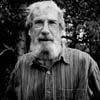Your shopping cart is empty!
Select currency
MENU

John Holloway was born in 1929 in Chelsea, London. He attended Chislehurst and Sidcup Grammar School before enrolling at Sidcup School of Art where he took a National Diploma in Design, specializing in his final year in painting. He then did post-graduate studies at Brighton School of Art where he took a Diploma in Arts Teaching, and where he also met fellow artist Denee whom he would marry. Together the couple had five children, two girls and three boys.
John Holloway had registered as a conscientious objector when, in 1950, he was called for conscription; instead of national service, therefore, he worked, first as a ward orderly, and then as an operating theatre technician at Queen Mary’s Hospital, Sidcup. Subsequent to this John Holloway became an art teacher employed by Hampshire County Council at a newly built secondary school near Havant; here he became Head of the Art Department and continued to teach at the school for a further ten years. In 1966 he moved to Brighton where he taught, initially on the B.Ed. course at the Polytechnic, and then on the BA Visual and Performing Arts course at the University of Brighton before taking early retirement in 1991.
John Holloway began to photograph the Sussex Downlands soon after arriving for his teaching post in Brighton. He concerns himself primarily with the traces left by man and animal - archeological and agricultural, but also with the ways in which these traces can be differentially photographed in prevailing weather and light conditions. ‘For a few weeks either side of the spring and autumn equinox’ writes Holloway, ‘the angle of the sun roughly corresponds with the angle of the slope of the north scarp of the hills in such a way that the texture of the tracks and terracettes is revealed” *. And in order to best photograph this richness of texture John Holloway works from a high vantage point, either from the top of a hill looking down, or, famously, through the use of a light aircraft. He focuses upon tracks and pathways, animal runs and enclosures, fences and furrows as well as rivers and dew-ponds; he notices archeological remains and repeatedly returns to the ancient chalk hill figures cut into the undulations of the Downland.
When still only eighteen years of age John Holloway visited the Towner, Eastbourne, to see an exhibition of the work of Eric Ravilious. Ravilious, of course, was also fascinated by the chalk figures (see Art Prints) and in certain respects the two artist’s work can be compared. There is a graphic clarity in the work of both - each artist finds a pattern within which to situate the elements, and evident also is a strong affection in the work of both for their chosen subject. But whereas Ravilious infuses his paintings of the Downs with a palpable romantic intensity, the affection in John Holloway’s photographs, though profound, is more restrained. John Holloway delights, however, in the details – the way tracks dot their way across snow laden cliffs, or wind creates shimmering ruffles on the waters of the Cuckmere River. And his accuracy of portrayal is the result of considerable knowledge - both as a naturalist and an ecologist. But it is these details within the photographs which tell of John Holloway’s ability, not only to see and to understand, but to sustain the kind of affection that stems from a desire to truly attend to that which he photographs.
John Holloway’s profound affection for the Downs, evidenced through the details in these photographs, transmits itself to the viewer. For all those who love the rolling hills, their close-cropped turf, their pathways, their ancient chalk figures, these photographs have an evocative appeal: they seem to capture the very experience of the Downlands.
There are no products to list.